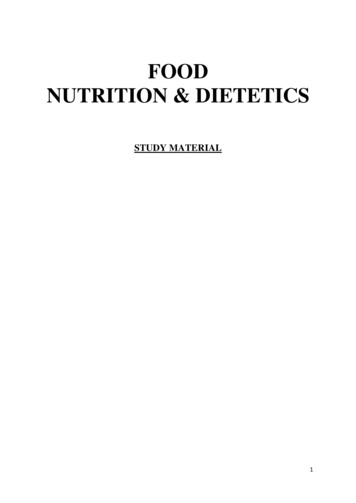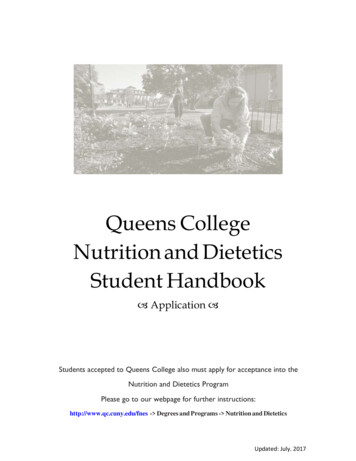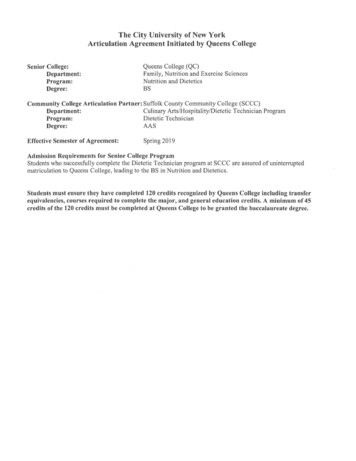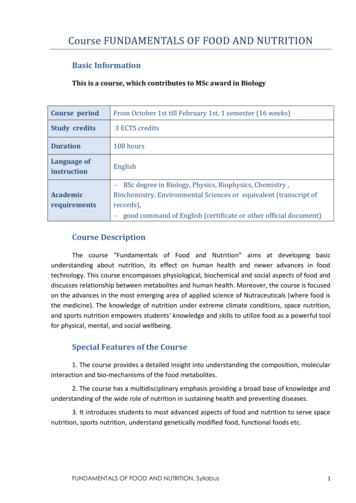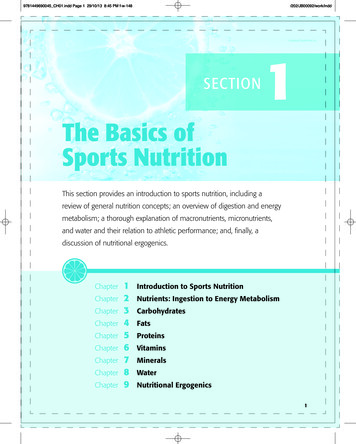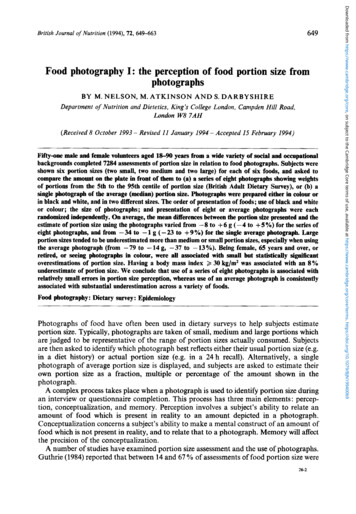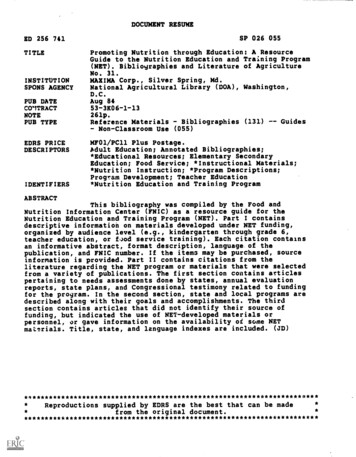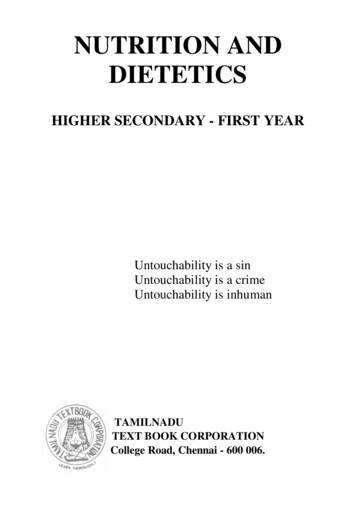
Transcription
NUTRITION ANDDIETETICSHIGHER SECONDARY - FIRST YEARUntouchability is a sinUntouchability is a crimeUntouchability is inhumanTAMILNADUTEXT BOOK CORPORATIONCollege Road, Chennai - 600 006.
Government of Tamil NaduFirst Edition – 2004CHAIRPERSONDr. P. Parvathi EaswaranFormer Dean of Home ScienceRetd Prof. & Head, Dept of Food ServiceManagement and DieteticsAvinashilingam Deemed University, Coimbatore 641043.REVIEWERSMrs Girija BalasundaramDr. V.AnuradhaS.G.LecturerDept of Home ScienceQueen Mary’ s CollegeChennai – 600 004Reader Dept of Food ServiceManagement and DieteticsAvinashilingam DeemedUniversity.Coimbatore 641043AUTHORSDr. Sheila JohnLecturer S.S.Dept of Home ScienceWomen’ s Christian CollegeChennai - 600 006.Mrs. Sadhana Rajmohan ParimalamLecturer, Dept of Home ScienceQuaid-E-Millat Govt College forWomen, Chennai-600 002Mrs. S. KarthigaLecturer, Dept of Home ScienceQuaid-E-Millat GovtCollege for WomenChennai-600 002Mrs. Anna Rangini ChellappaLecturer, Dept of Home ScienceQueen Mary’ s CollegeChennai – 600 004Mrs. B. S. VasanthiP.G. Assistant (Home Science)Presidency Girls Higher Secondary School,Egmore, Chennai – 600 008Price: Rs.This book has been prepared by the Directorate of SchoolEducation on behalf of Government of Tamilnadu.This book has been printed on 60 G.S.M paperPrinted by offset at:
PREFACEThis book is the outcome of the apt decision of theDirectorate of School Education, Government of Tamilnadu tointroduce Nutrition and Dietetics as an optional subject at HigherSecondary level.People are becoming nutrition conscious. Print andelectronic media pour out nutrition messages to the public. Supermarkets are flooded with foods of varied types, natural,processed, and ready to eat. The common man turns towardsnutrition scientists and dietitians for scientifically provedinformation on Nutrition and Dietetics. Hence it is essential thatNutrition and Dietetics is offered at various levels of education.This textbook on Nutrition and Dietetics includes contenton Food Science and Nutrition at plus one level, while at plus twolevel on Family Meal Management and Dietetics. At plus onelevel the student learns the rudimentary aspects while at plus twolevel the application aspects are included. The contents are soarranged that the student gains knowledge with application andskill.The authors collected scientifically proved and updatedinformation from various authentic sources. The reviewers andchairman offered valuable suggestions on the write up. It ishoped that the students will understand Nutrition and Dietetics inthe right perspective using this book.Grateful acknowledgement is expressed to the Directorand Joint Director, School Education, Government of Tamilnadufor this enriching opportunity.
1. FOOD GROUPS – A GUIDE IN MENUPLANNINGFood is the basic necessity of man. It is a mixture ofdifferent nutrients such as carbohydrate, protein, fat, vitaminsand minerals.These nutrients are essential for growth,development and maintenance of good health throughout life.They also play a vital role in meeting the special needs ofpregnant and lactating women and patients recovering fromillness.1.1 FUNCTIONS OF FOODFood may be classified according to their functions inthe body.Functions of icalfunctionsEnergy yieldingFoods(Carbohydrate,protein, fat)Body building foods(Protein)Protective foods(Vitamins andminerals)Fig1.1 Functions of food1
Physiological functions of food:i. Energy yielding foods:Foods rich in carbohydrates and fats are called energyyielding foods. They provide energy to sustain the involuntaryprocesses essential for continuance of life, to carry out variousprofessional, household and recreational activities and toconvert food ingested into usable nutrients in the body.The energy needed is supplied by the oxidation of foodsconsumed. Cereals, roots and tubers, dried fruits, oils, butter andghee are all good sources of energy.ii. Body building foods:Foods rich in protein are called body building foods.Milk, meat, eggs and fish are rich in proteins of high quality.Pulses and nuts are good sources of protein but the protein is notof high quality. These foods help to maintain life and promotegrowth. They also supply energy.iii. Protective and Regulatory foods:Foods rich in protein, minerals and vitamins are knownas protective and regulatory foods. They are essential for healthand regulate activities such as maintenance of body temperature,muscle contraction, control of water balance, clotting of blood,removal of waste products from the body and maintainingheartbeat. Milk, egg, liver, fruits and vegetables are protectivefoods.Social functions of food:Food has always been the central part of ourcommunity, social, cultural and religious life. It has been anexpression of love, friendship and happiness at religious, socialand family get-togethers.Psychological functions of food:In addition to satisfying physical and social needs, foodsalso satisfy certain emotional needs of human beings. Theseinclude a sense of security, love and acceptance. For example,preparation of delicious foods for family members is a token oflove and affection.2
3Fig.1.2 -Functions of food
1.2ICMR FIVE FOOD GROUPSTABLE – 1.AFive Food Group SystemFood GroupMain NutrientsI. Cereals, Grains and Products : Energy,protein,Rice, Wheat, Ragi, Bajra, Maize, Invisible fat Vitamin –Jowar, Barley, Rice flakes, Wheat B1, Vitamin – B2, FolicAcid, Iron, Fibre.flour.Energy,Protein,II. Pulses and Legumes :Invisible fat, Vitamin –Bengal gram, Black gram, GreenB1, Vitamin – B2, Folicgram, Red gram, Lentil (whole asAcid, Calcium, Iron,well as dhals) Cowpea, Peas,Fibre.Rajmah, Soyabeans, Beans.Protein, Fat, Vitamin –III. Milk and Meat Products :B12, Calcium.Milk :Milk, Curd, Skimmed milk,CheeseMeat :Protein, Fat, Vitamin –Chicken, Liver, Fish, Egg, Meat.B2IV. Fruits and Vegetables :Fruits :Mango, Guava, Tomato Ripe, Carotenoids, Vitamin –Papaya, Orange. Sweet Lime, C, Fibre.Watermelon.Vegetables (Green Leafy) :Amaranth, Spinach, Drumstick Invisible Fats,leaves, Coriander leaves, Mustard Carotenoids, Vitamin –B2. Folic Acid, Calcium,leaves, fenugreek leaves .Other Vegetables :Iron, Fibre.Carrots, Brinjal, Ladies fingers,Capsicum, Beans, Onion,Carotenoids, Folic Acid,Drumstick, Cauliflower.Calcium, Fibre4
Food GroupMain NutrientsV. Fats and Sugars :Fats :Energy, Fat, EssentialButter, Ghee, Hydrogenated oils,Cooking oils like Groundnut, Fatty AcidsMustard, Coconut.Sugars :EnergySugar, JaggerySource :Gopalan. C, Rama Sastri B.V. and BalasubramanianS.C., 1989, Nutritive Value of Indian Foods, NationalInstitute of Nutrition, ICMR, Hyderabad.Significance of the five-food group systemThe five food group system can be used for thefollowing purposes :i.ii.Planning wholesome balanced menus to achievenutritional adequacy.Assessing nutritional status – a brief diet history of anindividual can disclose inadequacies of food andnutrients from any of the five groups.Based on the assessment, nutrition education can beimparted to the individual.1.3.FOOD PYRAMID :The food guide pyramid was introduced in 1992 byUSDA (United States Department of Agriculture) as a generalplan of what to eat each day. The food guide pyramid is avaluable tool for planning a health promoting diet.By incorporating the principle of balance, variety andmoderation, an individual can still eat their favourite foodswhile following the food guide pyramid.5
SugarandoilMilkandMeatPulsesFruits andVegetablesCerealsFig.1.3 -Food guide pyramidSource:Srilakshmi .B 2003.Dietetics, New Age International (P)Publishers Ltd.Chennai.Balance:It means choosing food from different food groups.6
Variety:This means including different foods within each foodgroup. For eg. consuming a variety of fruits.Moderation:This means keeping serving sizes reasonable. Thisinvolves self control.The food guide pyramid provides recommendation forthe number of daily servings that should be consumed from eachof the food groups.The diagram Fig. 1.3, clearly represents that cerealsshould form the major bulk of the diet followed by fruits andvegetables, pulses, milk and meat products and sugars and oil.The portion size of foods for adolescents (13-18 years) is givenbelow.TABLE 1.BPortion size of foods for adolescentsNumber of Portions forAdolescentsFood GroupsPortion SizeGirlsBoysCereals and millets30 g1014Pulses30 g22Milk100 ml55Roots and tubers100 g12Green leafy100 g11VegetablesOther vegetables100 g11Fruits100 g11Sugar5g67Fats and oils5g55(For non-vegetarians substitute one pulse portion with oneportion (50 gm) of egg / meat / chicken / fish.)Source :Dietary guidelines for Indians – A manual (1998), NationalInstitute of Nutrition, ICMR, Hyderabad – 500 007.7
QuestionsPart- AFill in the blanks:1. Foods rich in carbohydrate and fats are calledfoods.2. Foods rich in are called body building foods.3. Foods rich in protein vitamins and minerals are calledfoods.4. The food guide pyramid is based on the principles of, and .Part- BWrite short answers:1.How are foods classified?. Mention the physiologicalfunctions of food.2.Give the ICMR classification of food groups.3.List the major nutrients present in fruits and vegetables.4.Give the portion size of foods for adolescents.Part- CWrite detailed answers:1. Explain the functions of food. Enumerate the purpose ofthe five-food group system.2. Give a diagrammatic representation of the food pyramidand highlight its role as a guide in menu planning.8
2. COOKING METHODS – MERITS ANDDEMERITSFood preparation is an important step in meeting thenutritional needs of the family. Food has to be pleasing inappearance and taste in order to be consumed. Foods like fruits,vegetables and nuts can be eaten raw but most foods are cookedto bring about desirable changes. The process of subjectingfood to the action of heat is termed as cooking.Objectives of Cooking1.Cooking sterilizes food: Above 40 C the growth ofbacteria decreases rapidly. Hence food is made safe forconsumption.2.Cooking softens the connective tissues of meat and thecoarse fibre of cereals, pulses and vegetables so that thedigestive period is shortened and the gastro intestinaltract is less subjected to irritation.3.Palatability and food quality is improved by cooking –Appearance, flavour, texture and taste of food areenhanced while cooking.4.Introduces variety – Different dishes can be preparedwith the same ingredients. (Eg.) Rice can be made intobiriyani and kheer.5.Increases food consumption – Cooking brings aboutimprovement in texture and flavour thereby increasingconsumption of food.6.Increases availability of nutrients – Example in raw egg,avidin binds biotin making it unavailable to the body.By cooking, avidin gets denatured and biotin is madeavailable.9
2.1 COOKING METHODSHeat is transferred to the food during cooking byconduction, convection, radiation or microwave energy.Cooking takes place by moist and dry heat. Moist heat involveswater and steam. Air or fat are used in dry heat.TABLE – 2ACooking methodsMoist HeatDry ingSteamingToastingPressure CookingBakingPoachingSauteeingBlanchingFrying2.2 MOIST HEAT METHODS2.2.1 Boiling:Boiling is a method of cooking foods by just immersingthem in water at 100 C and maintaining the water at thattemperature till the food is tender. Rice, egg, dhal, meat, rootsand tubers are cooked by boiling.Merits1. Simple method - It does not require special skill andequipment.2. Uniform cooking can be achieved.Demerits1. Continuous excessive boiling leads to damage in thestructure and texture of food.2. Loss of heat labile nutrients such as B and C vitamins ifthe water is discarded.3. Time consuming – Boiling takes more time to cook foodand fuel may be wasted.4. Loss of colour – water soluble pigments may be lost.10
2.2.2 StewingIt refers to the simmering of food in a pan with a tightfitting lid using small quantities of liquid to cover only half thefood. This is a slow method of cooking. The liquid is broughtto boiling point and the heat is reduced to maintain simmeringtemperatures (82 C - 90 C). The food above the liquid iscooked by the steam generated within the pan. Apple, meatalong with roots, vegetables and legumes are usually stewed.Merits1. Loss of nutrients is avoided as water used for cooking is notdiscarded.2. Flavour is retained.Demerits1. The process is time consuming and there is wastage of fuel.2.2.3 Steaming:It is a method of cooking food in steam generated fromvigorously boiling water in a pan.The food to be steamed is placed in a container and isnot in direct contact with the water or liquid. Idli, custard andidiappam are made by steaming. Vegetables can also besteamed.Merits1. Less chance of burning and scorching.2. Texture of food is better as it becomes light and fluffy.Eg. Idli.3. Cooking time is less and fuel wastage is less.4. Steamed foods like idli and idiappam contain less fat andare easily digested and are good for children, aged and fortherapeutic diets.5. Nutrient loss is minimised.Demerits1. Steaming equipment is required.2. This method is limited to the preparation of selected foods.11
2.2.4 Pressure cooking:When steam under pressure is used the method is knownas pressure cooking and the equipment used is the pressurecooker. In this method the temperature of boiling water can beraised above 100 C. Rice, dhal, meat, roots and tubers areusually pressure cooked.Merits1. Cooking time is less compared to other methods.2. Nutrient and flavour loss is minimised.3. Conserves fuel and time as different items can be cookedat the same time.4. Less chance for burning and scorching.5. Constant attention is not necessary.Demerits1. The initial investment may not be affordable toeverybody.2. Knowledge of the usage, care and maintenance of cookeris required to prevent accidents.3. Careful watch on the cooking time is required to preventover cooking.2.2.5 Poaching:This involves cooking in the minimum amount of liquidat temperatures of 80 C - 85 C that is below the boiling point.Egg and fish can be poached.Merits1. No special equipment is needed.2. Quick method of cooking and therefore saves fuel.3. Poached foods are easily digested since no fat is added.Demerits1. Poached foods may not appeal to everybody as they arebland in taste.2. Food can be scorched if water evaporates due to carelessmonitoring.3. Water soluble nutrients may be leached into the water.12
2.2.6 Blanching:In meal preparation, it is often necessary only to peel offthe skin of fruits and vegetables without making them tender.This can be achieved by blanching. In this method, food isdipped in boiling water for 5 seconds to 2 minutes depending onthe texture of the food. This helps to remove the skin or peelwithout softening food.Blanching can also be done by pouring enough boilingwater on the food to immerse it for some time or subjectingfoods to boiling temperatures for short periods and thenimmediately immersing in cold water. The process causes theskin to become loose and can be peeled off easily.Merits1. Peels can easily be removed to improve digestibility.2. Destroys enzymes that bring about spoilage.3. Texture can be maintained while improving the colourand flavour of food.Demerits1. Loss of nutrients if cooking water is discarded.2.3 DRY HEAT METHODS2.3.1 Roasting:In this method food is cooked in a heated metal or fryingpan without covering it. Eg. Groundnut.Merits1. Quick method of cooking.2. It improves the appearance, flavour and texture of thefood.3. Spices are easily powdered if they are first roasted.Demerits1. Food can be scorched due to carelessness.2. Roasting denatures proteins reducing their availability.2.3.2 Grilling:Grilling or broiling refers to the cooking of food byexposing it to direct heat. In this method food is placed above13
or in between a red hot surface. Papads, corn, phulkas, chickencan be prepared by this method.Merits1. Enhances flavour, appearance and taste of the product.2. It requires less time to cook.3. Minimum fat is used.Demerits1. Constant attention is required to prevent charring.2.3.3 Toasting:This is a method where food is kept between two heatedelements to facilitate browning on both sides. Bread slices arecooked by toasting.Merits1. Easy and quick method.2. Flavour improved.Demerits1. Special equipment required.2. Careful monitoring is needed to prevent charring.2.3.4 Baking:In this method, the food gets cooked in an oven or ovenlike appliance by dry heat. The temperature range maintained inan oven is 120 C – 260 C.The food is usually kept uncovered in a containergreased with a fat coated paper. Bread, cake, biscuits, pastriesand meat are prepared by this method.Merits1. Baking lends a unique baked flavour to foods.2. Foods become light and fluffy – cakes, custards, bread.3. Certain foods can be prepared only by this method – bread,cakes.4. Uniform and bulk cooking can be achieved. Eg. bun,bread.5. Flavour and texture are improved.6. Variety of dishes can be made.14
Demerits1. Special equipment like oven is required.2. Baking skills are necessary to obtain a product with idealtexture, flavour and colour characteristics.3. Careful monitoring needed to prevent scorching.2.3.5 Sauteing:Sauteing is a method in which food is lightly tossed inlittle oil just enough to cover the base of the pan. The pan iscovered with a lid and the flame or intensity of heat is reduced.The food is allowed to cook till tender in its own steam.The food is tossed occasionally, or turned with a spatula toenable all the pieces to come in contact with the oil and getcooked evenly.The product obtained by this method is slightly moistand tender but without any liquid or gravy. Foods cooked bysauteing are generally vegetables which are used as side dishesin a menu. Sauteing can be combined with other methods toproduce variety in meals.Merits1. Takes less time.2. Simple technique.3. Minimum oil is used.Demerits1. Constant attention is needed as there is chance ofscorching or burning.2.3.6 Frying:In this method, the food to be cooked is brought intocontact with larger amount of hot fat. When food is totallyimmersed in hot oil, it is called deep fat frying. Samosa, chips,pakoda are examples of deep fat fried foods. In shallow fatfrying, only a little fat is used and the food is turned in order thatboth sides are browned. Eg. Omlette, cutlets, parathas.15
Merits1. Very quick method of cooking.2. The calorific values of food is increased since fat is usedas the cooking media.3. Frying lends a delicious flavour and attractive appearanceto foods.4. Taste and texture are improved.Demerits1. Careful monitoring is required as food easily gets charredwhen the smoking temperature is not properly maintained.2. The food may become soggy due to too much oilabsorption.3. Fried foods are not easily digested.4. Repeated use of heated oils will have ill effects on health.2.4 COMBINATION OF COOKING METHODSBraising :Braising is a combined method of roasting and stewingin a pan with a tight fitting lid. Flavourings and seasonings areadded and food is allowed to cook gently. Food preparationsprepared by combination methods are :UppumaRoasting and boiling.CutletBoiling and deep frying.Vermicilli payasam Roasting and simmering.2.5 MICROWAVE COOKINGMicrowaves are electromagnetic waves of radiant energywith wave lengths in the range of 250 x 106 to 7.5 x 109Angstroms.The most commonly used type of microwave generatoris an electronic device called a magnetron which generatesradiant energy of high frequency.A simple microwave oven consists of a metal cabinetinto which the magnetron is inserted. The cabinet is equippedwith a metal fan that distributes the microwave throughout the16
cabinet. Food placed in the oven is heated by microwaves fromall directions.Fig. 2. 1- Microwave oven1.Door release button2. See –through window 3. Doorsafety lock system 4.External air vents 5.Control panel6.Identification plate 7.Glass tray 8.Roller ringSource: Srilakshmi B.(2003) Food Science , New AgeInternational (P) Publishers Limited.Chennai.Moist foods and liquid foods can be rapidly heated insuch ovens. Food should be kept in containers made of plastic,glass or china ware which do not contain metallic substances.These containers are used because they transmit the microwavesbut do not absorb or reflect them.Merits1. Quick method – 10 times faster than conventional method.So loss of nutrients can be minimised.2. Only the food gets heated and the oven does not getheated.3. Food gets cooked uniformly.17
4. Leftovers can be reheated without changing the flavourand texture of the product.5. Microwave cooking enhances the flavour of food becauseit cooks quickly with little or no water.Demerits1. Baked products do not get a brown surface.2. Microwave cooking cannot be used for simmering,stewing or deep frying.3. Flavour of all ingredients do not blend well as the cookingtime is too short.2.6 SOLAR COOKINGSolar cooking is a very simple technique that makes useof sunlight or solar energy which is a non-conventional sourceof energy.Solar cooker consists of a well insulated box which ispainted black on the inside and covered with one or moretransparent covers.The purpose of these transparent covers is to trap heatinside the solar cooker. These covers allow the radiation fromthe sun to come inside the box but do not allow the heat fromthe hot black absorbing plate to come out of the box. Becauseof this, temperature upto 140 C can be obtained which isadequate for cooking.Merits1. Simple technique – requires no special skill.2. Cost effective as natural sunlight is the form of energy.3. Original flavour of food is retained.4. There is no danger of scorching or burning.5. Loss of nutrients is minimum as only little amounts ofwater is used in cooking.Demerits1. Special equipment is needed.2. Slow cooking process.3. Cannot be used in the absence of sunlight – rainy season,late evening and night.18
Fig. 2.2-Solar cooker1.Solar plane mirror 2.Cooking container3.Glass sheet4. Cover 5. Insulation material glass6.Outer box7. Handle 8.Mirror support 9.Hinged adjuster and guideSource: Srilakshmi B.(2003) Food Science , New AgeInternational (P) Publishers Limited.Chennai.19
QUESTIONSPart- AFill in the blanks:1. is a method of cooking foods by just immersingthen in water at 100º C2. Simmering of food in a pan with a tight fitting lid using smallquantities of liquid to cover only half the food is known as3. When steam under pressure is used the method is known as4. is a method use to prepare cakes.5. When food is totally immersed in hot oil, it is called.6. is a combined method of roasting and stewing in apan with a tight fitting lidPart- BWrite short answers1. What are the objectives of cooking food?2. Bring out the differences between stewing, steaming andsauteing.3. What is the best method of preparing rice and dhal? Justifyyour choice of cooking method.4. Write a note on solar cooking and its merits and demeritsPart- CWrite detailed answers1. Compare the various moist heat methods of cooking.Highlight the merits and demerits of each type.2. Give a brief account about the principles, merits anddemerits of microwave cooking.3. Explain the cooking method employed in the preparation of(a) Bread, (b) Idli, (c) Chapathis4. Discuss the dry heat methods of cooking?20
3.CEREAL AND CEREALPRODUCTSCereals form the staple food of the human race. In Indiawheat, rice, maize (corn), oats, jowar, ragi and bajra are thecommon cereals and millets used.3.1 STRUCTURE OF RICE AND WHEATThe overall structure of all cereal grains is basicallysimilar. Rice grains resemble wheat but is smaller than that ofwheat. It is flattened laterally and has no ventral furrow.Wheat cereal grains are composed of an outer bran coat,a germ and a starchy endosperm.ricewheata. Branb. Endospermc. GermFig. 3.1 Structural Parts of rice and wheatSource: Sumati Mudambi, R and Shalini, M. Rao 1989 FoodScience. New Age International (P) Publishers Ltd, Chennai.21
The longitudinal structure of wheat grain depicting the variouslayers is represented diagrammatically in fig.3.2Fig. 3.2 Longitudinal structure of wheat grainSource: Srilakshmi B. 2003 Food Science. New AgeInternational (P) Publishers Ltd Chennai.Bran:Bran is the outer layer of the kernel and constitutes 5percent of the kernel. During milling the bran is discarded. Branis rich in fibre and minerals. It is also a good source of thiamineand riboflavin.Aleurone Layer:This is located just under the bran, which is rich inprotein, phosphorus and thiamin and contains moderate amounts22
of fat. The aleurone layer makes up about 8 percent of thewhole kernel. This layer is lost in the milling process along withbran.Endosperm:This is the large central part of the kernel and constitutes84 – 85 percent of the kernel. The endosperm cell consistsmainly of starch and protein and little mineral matter and fibreand only half a trace of fat. The vitamin content of theendosperm is low.Germ :This is a small structure at the lower end of the kerneland is separated from the endosperm by the scutellum. It makesup 2 – 3 percent of the whole kernel. It is rich in protein, fat,vitamins and minerals.The germ serves as a store of nutrients for the seed whenit germinates. During milling some of the germ is lost alongwith the bran and aleurone layer.3.2 NUTRITIVE VALUE OF CEREALSCereals are an important and economic source of energy.Hundred grams of cereals supply 340 kilo calories of energy.Cereals are also a significant source of proteins (8 – 11 percent)in the diets of people whose staple food is cereals.However, cereal protein is incomplete as it lacks anessential amino acid, lysine. This lack is made up when cerealsare eaten along with other protein foods such as dhals, pulsesand milk.Wheat flour contains glutelin and gliadin as proteinswhich are commonly known as gluten. The strength of thewheat flour is based on the quality of gluten used.Whole grains chiefly furnish starch, proteins,minerals, B -Vitamins and fibre.Refined cereals lose part of the protein, minerals, and B Complex vitamins in milling. They contain a little more starchthan whole cereals.23
Whole grains contain more vitamins, minerals and fibrethan refined grain and are valuable dietary sources of iron,phosphorus, thiamine and fibre.3.3 PARBOILING AND MILLING – EFFECT ONNUTRIENT CONTENTParboiling is a process of soaking paddy in water at 65 70 C for 3 – 4 hours. The water is drained and the soakedpaddy is steamed in the same vessel for 5 to 10 minutes. Thepaddy is dried in the sun or mechanically dried.Advantages of Parboiling:1. Dehusking of parboiled rice is easy.2. Grains become tougher resulting in reduced lossesduring milling.3. Part of the scutellum and germ which are rich in B –Vitamins get fixed to the grain and hence loss of B –Vitamins are less. The retention of thiamine, riboflavin,niacin and folic acid in parboiled rice is greater than thatof polished or hand pounded rice.4. It improves digestibility.5. It swells more when cooked to desired softness.Milling:Milling is the process, which removes the coarse outerlayer of bran and germ. Paddy is milled by hand pounding ormechanical rice millers.The process of milling involves the following steps. Rice is passed through two stone or rubber discs rotatingat different speeds and by shearing action on the grain,the hull is pulled away. The whole kernel from which thehulls have been removed is known as brown rice. This is then milled in a machine called pearler to removecoarse outer layers of bran and germ by a process ofrubbing, resulting in unpolished milled rice. Someamount of breakage of rice occurs in this milling.24
Unpolished rice is liable to develop rancidity and so it ispolished in a brush machine which removes the aleuronelayer and yields “polished rice”. Sometimes the polished rice is further treated in a deviceknown as trumbol to give a coating of sugar and talc toproduce a brighter shine on the grains. Rice is separated from the broken kernels. Large kernelsare called second heads, medium ones are calledscreenings, smallest ones are called the brewers rice.The percentage loss of different nutrients during pyridoxine (Vitamin B6) 50%.The degree of milling determines the amount of nutrientsremoved.Losses during milling can be compensated by the followingprocesses. By under-milling or unpolishing rice the loss of nutrientscan be reduced. A second method is that of increasing vitamin retentionby processing the rough rice prior to milling. This isdone by parboiling which is commercially known asconverted rice. Another means of remedying the losses occurring in themilling of rice is the artificial enrichment of the grain.A premix has been developed in which the rice is wettedwith a solution of thiamin and niacin, then dried. Asecond coating of iron pyro phosphate is distributed onthe rice.The rice premix is highly resistant to washing, cookingand storage losses.25
(a)unmilled raw rice(b) Milled raw rice(c) unmilled parboiled rice(d) milled parboiled riceFig. 3.3 – Effect of milling of raw and parboiled rice(a) Unmilled raw rice - Germ and pericarp are intact in rawrice, Vitamin B1 and other vitamins are concentratedmainly in the germ and pericarp. When these areremoved by milling, the grain has lost most of itsvitamins.(b) Milled raw rice – Germ and pericarp are removed(c) Unmilled parboiled rice- The vitamin has diffusedthrough the endosperm26
(d) Milled parboiled rice : Although germ and pericarp havebeen removed, the grains still contains most of thevitamins3.4 NUTRIENT CONTENT OF RAGI, MAIZE, ANDJOWARRagi :Ragi or finger millet is widely consumed without anyrefining by many people in rural areas. It contains B Vitaminsbut is po
Nutrition and Dietetics is offered at various levels of education. This textbook on Nutrition and Dietetics includes content . Food is the basic necessity of man. It is a mixture of different nutrients such as carbohydrate, protein, fat, v
